Amelie vs Midnight in Paris: How is Paris Portrayed?
This article looks at how Paris functions as a place in two notable films. One of these scripts is Amelie (Jeunet, 2001) written by Jean- Pierre Jeunet and Guillaume Laurant. This story is viewed from the perspective of a French working-class woman in Paris who, after hearing about the death of Princess Diana, decides to dedicate her life to bring joy to others and ultimately herself. The second script is Midnight in Paris (Allen, 2011) written by American screenwriter and director Woody Allen. This story is based on a modern-day writer, Gil, who, while on a vacation, finds himself stepping back into, what he considers, the golden era of Paris and falls in love with Picasso’s mistress.
Amelie
Jaunet’s script for Amelie could arguably be written for a different location. The evidence suggests that the characters and the story could work in other cities because Jeunet suggests a greater sense of realism and working-class culture rather than a romanticised notion of Paris that seems prominent in popular culture. However, the chosen location of working-class Paris could work for the story because the scriptwriters are French and may have a greater understanding of Paris and French cultural norms. Roger Ebert reviewed Amelie in 2001 and had a contrasting theory about how Paris was represented.
‘Of course, this is not a realistic, modern Paris and some critics have sniffed about this too: it is clean, orderly, safe, colourful, has no social problems and is peopled entirely by citizens who look like extras from ‘An American in Paris.’ (Ebert, 2001)
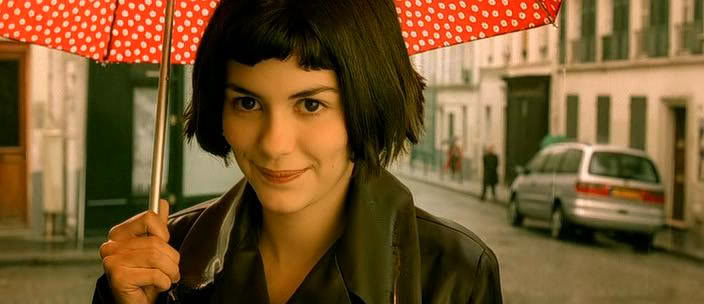
Ebert’s notion that the portrayal of Paris in Amelie is unrealistic could be challenged with the following evidence from the script. Jeunet creates a working-class image of Paris, the backstreets, the café’s and bistros, even the selection of diverse characters draw the audience into the depths of a real Paris. The characters themselves are not as Ebert describes, they have their own quirks and social issues ranging from mental problems to disabilities. One character, Dufayel, is a hermit and will not leave his apartment, Amelie herself comments on the fact that within six years of living in the same place, their paths had never crossed. (Jeunet, 2001) Another is a café dweller, Joseph, who stalks his ex-girlfriend and makes recordings of her every move through his own jealous nature and paranoia. Not only this but Amelie’s love interest in the story, Nino, works in a sex shop and sometimes works as a performer on a ghost train. He could be viewed as unusual and offbeat, particularly when he mentions to a colleague that doctors believed he ate his twin in the womb. (Jeunet, 2001) What all these characters seem to demonstrate is a sense of isolation. This reflects the main issue of the protagonist. Amelie is portrayed in the script as lonely and isolated, particularly during her childhood where her only friend is a suicidal fish. It becomes more apparent throughout the story that the characters feel alone within a big city and Amelie takes it upon herself to fix this. The reason for this could be that she herself needs fulfilment to counteract her own loneliness and from this, she creates connections and brings all these Paris dwellers together.
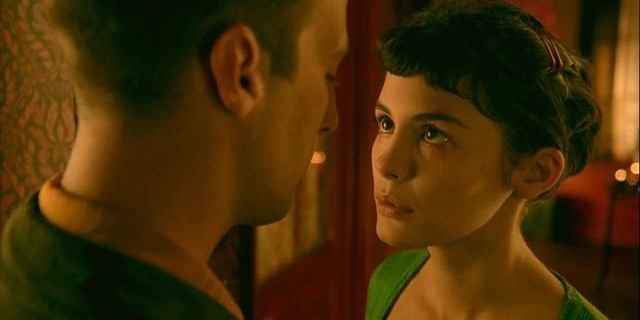
Since each character is depicted as lonely in different ways, using a big city, such as Paris, works for this script. If it were to be set in a small French town such as Chocolat (Jacobs, 2000) each character has in-depth knowledge about each other’s lives, whereas, in Paris, Amelie learns more about the characters as the audience does through her interaction. For example, when Amelie goes to the grocery store, she observes the way the grocer cruelly treats his assistant and she takes it upon herself to seek revenge on his cruelty by hijacking his apartment.
Amelie, though created in 2001, is set in 1997. Jeunet timed the story at the time of Princess Diana’s death in Paris, this also adds to the realism of the script, a real-life person, who influenced the lives of millions with good deeds and acts of charity. Not only this but it contradicts Ebert’s impression that Paris in this script is ‘safe’ and ‘clean’. (Ebert, 2001) This real event proves that Paris like any other city is just as dangerous and just as gritty and it draws away from the romantic idea of Paris and establishes a realistic perception. This event sets in motion the rest of the story as a sequence of happenings carry the story from that moment. Amelie choosing to do good deeds as if inspired by Princess Diana, and in this way, brings the community together and makes them happy through her own unconventional methods.
So, to counteract Ebert’s point, Jeunet has a way of establishing a realistic Paris that doesn’t appear ‘clean’ or ‘orderly’(Ebert, 2001) and in this way, Paris works as an ideal place for the story to unfold.
The way in which Paris works within the script of Amelie is also through the visuals. If it was written for a different city, these visual, cultural ideas would be changed to fit the location. There is a moment in Amelie where sensorial imagery transports the audience to Paris. Jeunet creates this scene where Amelie notices an elderly blind man on the pavement and she assists him across Paris and tells him about different things she notices as they walk along together. The scene describes in meticulous details of a typical Paris street, like the old lady who is dressed like a young child, the chickens roasting on a spit, crabs with their claws taped together. (Jeunet, 2001) This depiction of place suggests a deeper part of a Parisian street, places that a tourist may not venture to.
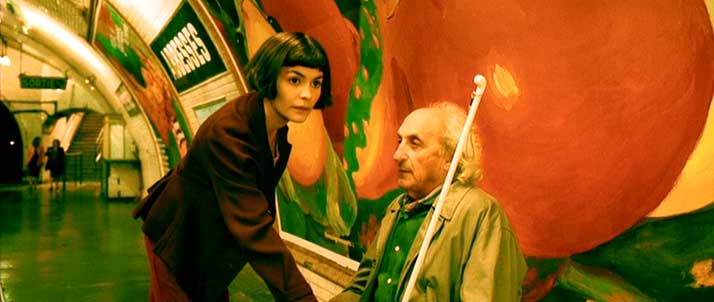
Midnight in Paris
Allen seems to create a richer and glamorised portrayal of Paris through the eyes of an American tourist in his script for Midnight in Paris. Contrasting to the characters in Amelie, Allen’s characters never deal with financial struggles or the working class cultural norms of Paris. The characters are staying in five-star hotels and Owen Wilson’s character is drinking in bars with some of the richest and most influential men during the 1920s; F. Scott Fitzgerald, Ernest Hemmingway, and Cole Porter. Furthermore, unlike Amelie (Jeunet, 2001), Midnight in Paris can only work in Paris, as the city is portrayed as a personified character which influences everything in the story in the past and the present. The following evidence supports this idea. Allen’s use of time determines the importance of Paris within the story. Allen does this by transporting the audience to Paris at a different time from modern to the Jazz era to the 1900s. By doing this he also opens the story up to French audiences with a conscious knowledge of French culture. Taking French audiences back to a different time could change the experience of watching an American’s take on a European city. For example, when Gil first steps back into the 1920s the visual description creates this picture of Paris as bohemian with glamorous parties, elegant dresses, liquor, and cigarettes. (Allen, 2011) From this, a French audience could get a glimpse at Paris from a different time.
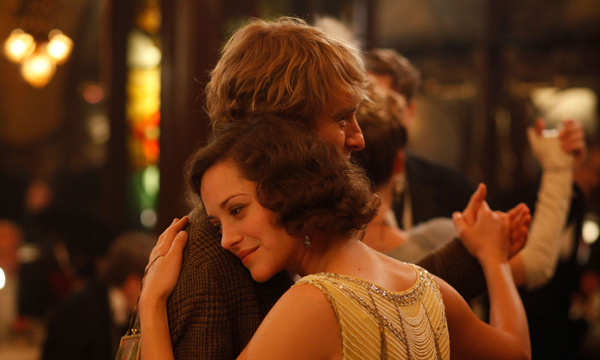
Allen’s depiction of Paris in Midnight in Paris also works as a mirror for the protagonist’s life in America. The character has an ambition for a different life but his true problem is his wife, who is his antagonist. He meets Marion Cotillard’s character in the 1920s who is the same as him and therefore becomes the love interest of the story. There is a scene in the script where Gil and Hemmingway are at the house of Gertrude Stein. There, Gil meets Adriana. He is instantly taken with her and during a conversation, Adriana expresses that she has always had a great charisma for the past. Gil agrees and says that he was born too late. Gil at this point seems so taken with her that he doesn’t pick up on the warning signs when Adriana talks of the Belle Époque Paris era, her history and how she would have found it perfect – the sensibilities, street lamps, and kiosks. (Allen, 2011) This later becomes an issue for the pair even though they share this idea that history is better than the present. Allen uses this to his advantage when it gets to the scene where Gil and Adriana find themselves in 1900s Paris. Throughout the film, Gil has been trying to escape the modern Paris and immerse himself in the culture of the 1920s scene where he meets influential people of the time, writers, musicians and indeed artists. In the opening dialogue, Gil converses with his fiancé, Inez. Gil expresses enthusiasm about Paris, saying ‘There is no city like this in the world. There never was.’ (Allen, 2011). Inez has a more realistic view of Paris as she finds ‘it’s become so touristy.’ (Allen, 2011) Gil agrees to a certain extent and his perspective of modern-day Paris is established in the following line which then serves as the function for driving the story.
‘Well, that’s just the awful era we live in but can’t you just imagine what this was like before…god you just can’t imagine what it was like years ago.’ (Allen, 2011)
This initial moment serves a purpose later in the script. As the reflection of the story, Adriana, the mistress, wishes to escape her present time in the 1920s to live in her history, the Belle Époque. Gil, however, loves the jazz age.
‘The twenties are full of strife and uncertainty. But think of it, Gil —the two of us— in a lovely art nouveau home— I’ll work in the fashion world— I love the styles —you can write … it’s the age of Debussy and Guimard. Maybe you can meet Balzac.’ (Allen, 2011)
In this extract from the screenplay, Allen creates this idea of a historical, beautiful Paris through the eyes of a woman living in her own present. Adriana’s view on Paris differs from Gil’s and ultimately leads to the downfall of their romance. It is also the eye-opening moment for Gil as it becomes apparent that no matter what place or time he is in or which woman he chooses to be with, he will never be satisfied. It becomes apparent to the audience and to the protagonist, Gil, that the main issue he has is his wife. Adriana then becomes the reflective character in the story and then Lea Seydoux becomes the eventual love interest in the modern-day Paris, for she is in tune with its culture and history but is still very much in the present. Cleverly Allen’s female characters all have a function within the script that reflects how Gil understands the place he is in. His wife is New York, he’s bored with the life he’s living as a screenwriter and he’s needing an escape to a different place with a different culture, his heart isn’t there. Cotillard’s character is Paris of the golden age. He’s enticed by her and the historical glamour of her era, she is his midnight escape. Lea Seydoux, however, is Paris of the present moment, and Gil finds in her what he is looking for in Paris and ultimately his own life.
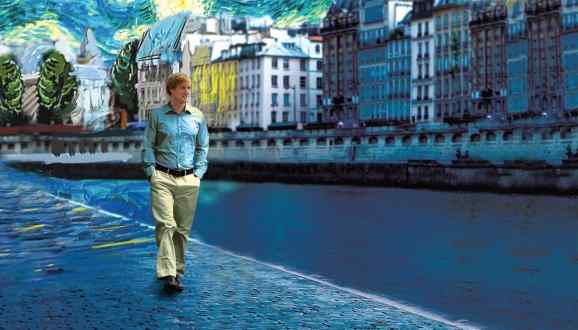
Through this investigation into how place functions within a script, it becomes apparent that Jeunet’s approach to establishing Paris within his script for Amelie is channeled through his diverse selection of characters and his visual, sensorial descriptions. They work as a cultural device to drive the story and portray Paris in a realistic light, distracting from the romanticised notion that is perceived through other screenplays or novella. Not only this but through the visual imagery in the script Jeunet creates an experience of being within a working-class city and establishes cultural normality and in so doing, gives the audience an in-depth look at the realities of a big city.
Allen’s approach depicts a glamourous Paris in his script for Midnight in Paris. It seems to focus on the luxurious imagery and a rich history. He draws upon the romance that surrounds Paris as an ideal, as the romantic city of the world. He does this through the eyes of his protagonist whose dialogue and apparent enthusiasm for the city makes himself and the location almost symbiotic, Gil needs Paris as his escape and in a way Paris needs him to bring to life its history and romance, for in some character’s opinions it has become too ‘touristy’ (Allen, 2001). Allen’s use of time establishes Paris because he portrays a grand history of the city and the people within it, the writers, the musicians, the painters and the women; Adriana, Zelda Fitzgerald, and Gertrude Stein. He provides this historical Paris as a way of transporting the audience to somewhere else, like his main character who wants to escape the modern world and emerge himself in a place where he thinks he fits in. Not only does it transport those who are influenced by the romanticised Paris but also French audiences who live and breathe the culture and are looking for something different within a script. They may not view a modern Paris as an American would for example.
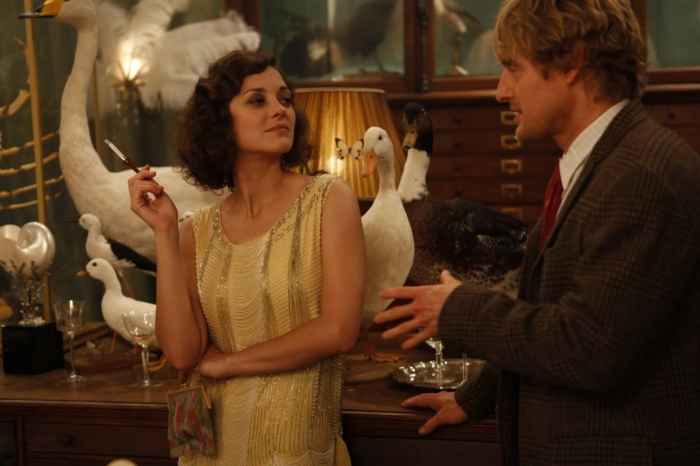
What do you think? Leave a comment.











I dare you all to not to fall in love with Amelie. 🙂
I LOVE Midnight in Paris! I went to Paris as a preteen and unfortunately was too young and immature to really appreciate it. This movie makes me fall in love with Paris and eager to visit again.
I recommend “Paris, Je T’Aime”.
Basically an anthology of short films set in Paris. Featuring directors like the Coen Brothers and Alexander Payne, and a lot more.
I love Midnight in Paris. The scenes of Paris were enough to help make one fall in love. The music was superb! Having all the artists and writers show up was the ultimate name dropping contest! Their caricatures were hysterical! Casting Adrien Brody as Salvatore Dali was mind-numbing, combined with the surreal discussion about a rhino.
I think Owen Wilson is the perfect Woody Allen by far. He has a sort of naivete that seems to fit perfectly with who Woody seems to be and the combination of Owen’s good looks with Woody’s humor is riveting!
Of course the “nostalgia” theme and the -I really want to be somewhere else because it’s too boring here- give the storyline a whole other layer of meaning. For we artists and writers it’s one of the things that sparks our creativity.
I expected it to be very nostalgic, so I was quite surprised by the stance Allen took in the end. I suppose he managed to have his cake and eat it.
Few cities have as indelible a presence in film as Paris.
These are simply the very best movies to inspire visits to The City of Light. I visit several times each year and plan to share the locations with my clients.
I’ve got nothing against Woody Allen, I’ve seen a few of his films, liked some of them. I just found myself feeling insulted by this one – I genuinely want someone to properly explain why this film is any good, because I have this uneasy feeling that I must be wrong about it.
I went into Midnight in Paris having no idea of the plot, and I have to say that has been made in recent years that’s truly made me travel with the character. Woody Allen managed to time the character’s acceptance of the situation at the same time myself (and my friend who I was seeing it with) did. I have to admit, I didn’t know who every person in the film was, I have done little of 20th century literary and artistic study, so this was a nice little article to read over.
Beautifully done explanation. I saw Amelie on the big screen 3 times.
Great article about the movies and its locations. I really enjoyed these movies, but I enjoy any movie filmed in Paris!
I love Amélie so very much; it’s one of the best French films not just of recent times but of all times. ^_^
Amelie isn’t just a film, its art, portraying human feelings and senses in the best and purest way possible.
Thank you for sharing! Just returned from a week in Paris and had seen both movies earlier, but so much more special with having seen it and experienced Paris.
Loved it so much we are returning next year for 16 days at one of your lovely apartments.
Thank YOU!
Refreshing to see Owen Wilson not going through the motions and actually acting.
I have never watched any of Allen’s movies before and i don’t know how i lost all my freaking last years without hitting any of his movies.
Amelie is in essence life.
What a wonderful virtual trip back to Paris!
I’ve seen the films multiple times in the theatre and plan to buy the blurays just so I can continue to relive my previous trip to Paris.
Nice article, thanks a lot for writing it.
I wish sometimes real life was more like Amélie.
Gorgeous films, some of my favourites!
Too much stress? Too many business meetings? A too busy family life? You feel somehow exhausted? It is time for a massage release!
Interesting article, especially if you happen to have visited Paris. I told myself my romantic notions about the city were unrealistic and silly, but even in my late twenties, the real Paris was still disappointing in some ways. Then again, it is still Paris. 🙂
Nice work. It is always interesting to examine the different presentations of environments. Paris especially has always had a strong characterisation. Look at Victor Hugo’s work where in Les Miserables Paris is in fact structured as a mother figure.
Amelie is totally Paris portrayed
Few cities have been able to almost universally claim a personified status in film. This speaks to the magic of Paris.
The degree to which Paris is romanticized has always interested me
Interesting to see the varying perceptions of Paris on part of each filmmaker, which are certainly influenced by their own lived experiences. Amelie really does tap into that gritty way of life in Paris, whilst Midnight in Paris is in direct dialogue with the more romanticised versions that we find within the Hollywood lexicon. Having visited Paris four times in my 22 years, I love that the city really oscillates between the two!